I can’t believe that it has almost been a year since I finally bought my first ever powerchair, the Rascal P321 (also called my ‘Mario Kart’ or ‘The Dizzy Rascal’ by my friends – cos I have PoTS and am always dizzy, gettit?)
It truly was a long time coming, and I’ve written a lot about my experiences as a new wheelchair user, both positive and negative, and generally how life-changing a decision it has been over on my Instagram.
I’ve learned so much in that time about wheelchairs, accessibility, discrimination, and toeing that weird line between visible and invisible disability. It has genuinely been, alongside my beloved robot-bed, the best thing I have ever purchased.
As much as I love that chair, it’s not something that I found easy to transport. In spite of the claims of it being ultra-light and easy to take apart, the pieces are extremely heavy, they take up a lot of space in the car, and even the strong able-bodied people who help me get out and about got frustrated pretty quickly when taking it in and out of cars. It has caused a fair amount of problems as soon as there was a tiny step, requiring some huffing and puffing to lug it onto the tube that was supposedly already accessible. Sigh. London.
Because of this, it wasn’t one that we felt was worth the hassle of taking on a plane or train, especially to some of the inaccessible places where we travel out of necessity, and instead we used a manual chair whenever we went somewhere we knew we’d have an issue.
I bloody hated it. I finally had a taste of freedom and controlling my own chair, only for it to be ripped away from me because my chair couldn’t always handle what we needed. It also wasn’t easy for Sebastian to push me in a manual chair and suitcases on cobblestones, so things were always pretty stressful when we were out of the country! The only place I took it to (and it was the best and most accessible thing ever) was Disney. But that’s not exactly the real world!
It’s one of those things where, as a new wheelchair user, I didn’t really know exactly what I would want or need. And as much as my Rascal is in many ways perfect for me, in others it really isn’t. Out of curiosity, I started looking into new powerchairs that would perhaps travel better than the one I already had, and kept coming across foldable chairs online. They seemed like an option that was worth pursuing, and was lucky to get my hands on one of the brand new Foldalite powerchairs.
CareCo, the company where I actually bought my little Rascal last year, have very kindly collabed with me, and gifted me the Foldalite to test out and use in exchange for a review. As always, this will be my entirely honest opinion of my experience with the chair.
An important thing to note
As with nearly everything disability related, what we need from a powerchair can vary dramatically from person to person. We are, after all, individuals with individual needs.
For the record: I use a chair for chronic pain and fatigue reasons. This means I have limited mobility and am able to pop in and out of the chair if necessary (and is something I do quite often to make life easier getting to and from where I need to be). I know many people can’t do that, so it’s something to keep in mind as you read this.
I’m often unable to manoeuvre the real-world in a chair alone, unless it’s somewhere I know is totally accessible, so I generally only go out in a chair when I’m both well enough and when I have someone with me who is able to pick it up in case I get stuck. A lot of this is still a confidence issue for me.
On top of that, there are so many factors, including financial, size, and travel needs, that go into purchasing a chair. In an upcoming post, I’ll be speaking with experts to write a post on what we need to know and think about when we’re looking to buy our first chair, including my personal experience of being totally lost and confused with it all, which will hopefully give you the tools to feel more confident when set out into this new and exciting world.
I’m not pretending to know everything about wheelchairs, or that my experience will match up with yours. These reviews are my honest opinion and based on my personal experiences and mobility needs. Yours may be different, and that is fine!
The review
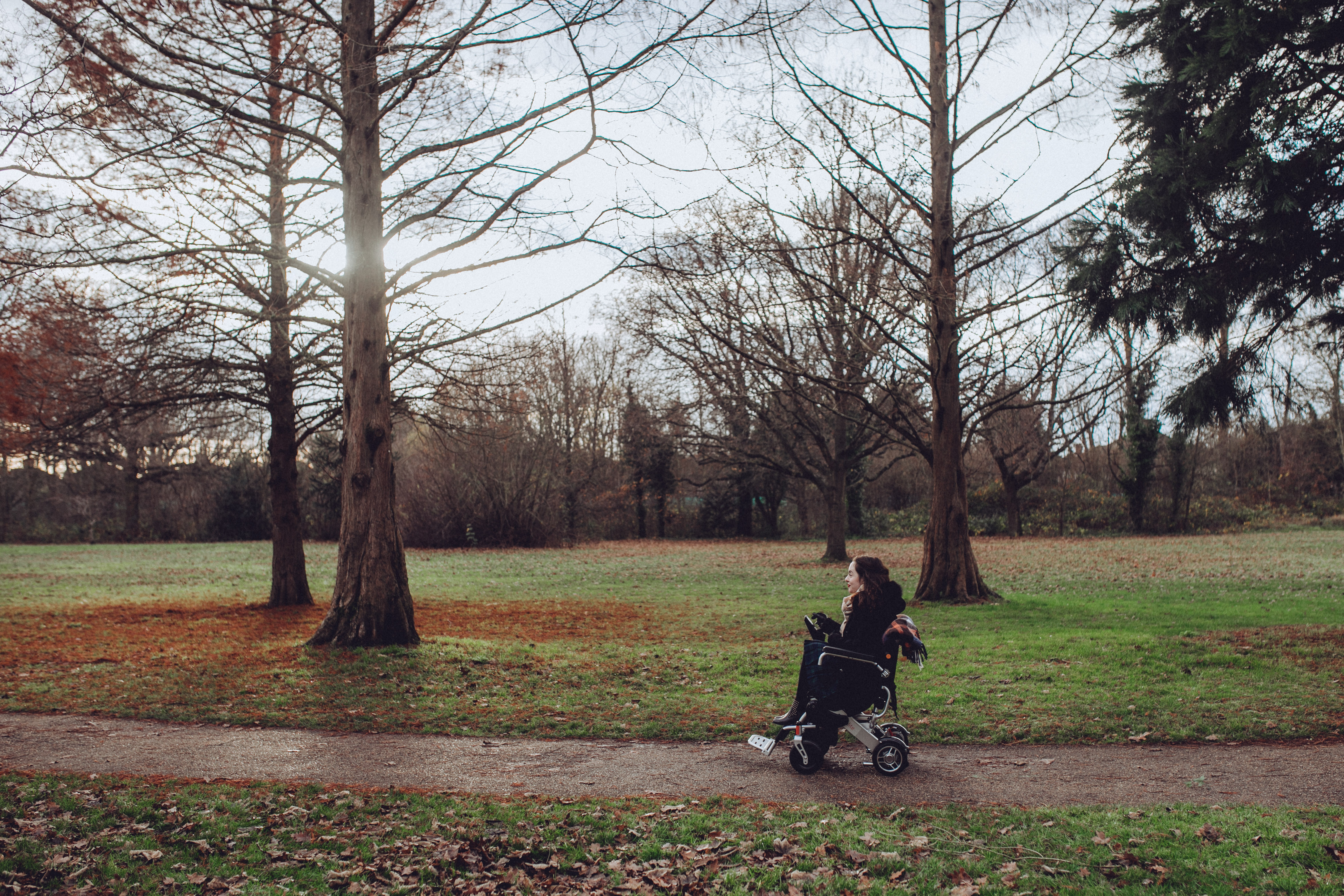
The name of the chair pretty much speaks for itself. It is a powerchair. That folds. And is…light!
At 25kg (3st 13lbs), it’s significantly lighter than my 45kg Rascal, but is still far too heavy for me to fold by myself. Yay for shoulders that fall out and no arm strength! However, it’s something that stronger people in my life are able to easily manage.
My hope for the chair was that it would be easy to take on and off of planes and trains when travelling, whilst also being comfortable enough for me to be able to stay in it for hours at a time. It was also important to me that it make Sebastian’s life easier, because he has hurt himself a few times trying to drag my Rascal when we’ve been stuck.
The chair costs £1999.00 (with VAT relief) and £2398.80 inc VAT from CareCo, and they will also do a price match if you find it cheaper elsewhere (see their terms and conditions for that here). Cost-wise it is nearly £1000 more than my Rascal, which put it out of my price-range when I was first looking to buy a chair.
It also comes with free courier delivery to your home, 12 months parts and labour warranty including home engineer call out, as well as 30 days free powerchair insurance and breakdown cover.
Aesthetics
When I was looking for my first chair, my dad was really pushing for me to get a folding chair like this, but I really wasn’t sure. Like, we actually argued about it. I could see the merit in having a chair that was this transportable, but…but…
It might sound shallow, but I really didn’t want one at the time, and a lot of that came down to aesthetic reasons. Coming to terms with becoming a wheelchair user (and making my mostly invisible disabilities visible) was in part tied up with how I looked in public. If people were going to stare (which they do), I needed a chair that felt very ‘me’ and made me feel young and cute and confident. And, most importantly, not medicalised.
The second I sat down in the Rascal, I just knew it ‘suited’ me. As silly as that may sound to some – it’s like finding the perfect pair of jeans. It just felt right. Even a year later, when my mum sees me in it, she comments on how much it suits me.
That’s not to say I dislike the aesthetics of this chair. It just has a very different vibe to my Rascal. For comparison:
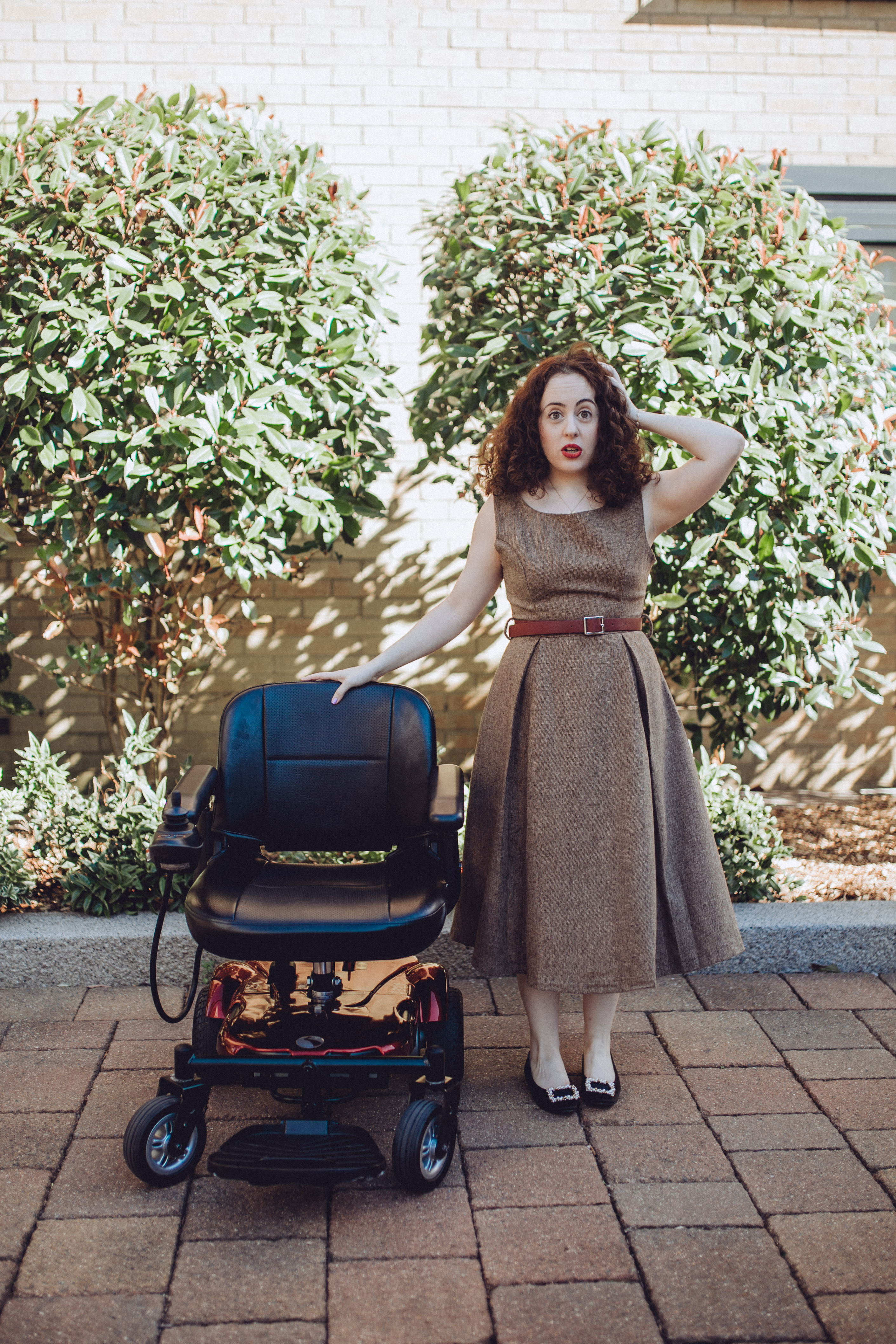
The biggest difference for me is in the overall structure and the seat. However, the Foldalite is still pretty sleek and modern looking. It *looks* lightweight and a lot less bulky than many chairs I’ve seen. And I’ve already had a number of compliments on it from people that I know and strangers who are also wheelchair users.
For someone who likes a pop of colour, the chair is available in electric blue, but it felt a bit too ‘racer’ for my liking. I do like it in the classic silver colour that I have, although one day my dream matte millennial pink powerchair dreams will come true.
There’s a pretty clever trick used on the frame to make the seating area feel ‘wider’, so it feels incredibly spacious. They have a ‘pro’ model that can hold a weight of up to 150kg, and is built for people with a larger frame. At 4ft9, however, even this chair feels a little bit too big for me (more on that later).
the battery
The chair comes with two lightweight, removable lithium-ion batteries. This was one of my biggest draws to the chair, as they’re flight-safe. All we had to do was take them out of the chair and have them poking out of our backpacks before we folded the chair up and the staff put it on the plane. The batteries are light, especially in comparison to the extremely heavy brick that I was used to with my Rascal.
The specs state that the chair has a max range of 15km at a max speed of 6km/h. I’m generally able to get where I need to go since I’m not out for that long at a time, and for my needs, I never ran out of power.
One of my other favourite features of this chair came as a pleasant surprise: you can actually charge the battery separately from the chair itself. You can, of course, plug it in directly, but you’re also provided with cables that allow you to take one out of the chair to charge, while running only on the remaining battery.
I keep the charger and cables in the storage space under the seat, and it leaves me feeling confident that just in case I’m out for longer than expected, I can simply plug a battery in without needing to restrict my use of the chair, and is also helpful if you’re space limited and unable to store your chair in your home.
OUT & ABOUT
The chair is built for travel, and, as the name suggests folds down to almost a wheelie suitcase type thing. Unfortunately, it’s too heavy and too stiff for me to fold myself (again, this is an EDS weakness in my entire upper body problem), so I am dependant on someone else to do this for me. But this would be the case with any chair I use.
There are a number of steps to fold it down, but my dad and boyfriend both got the hang of it very quickly, and it was definitely a huge speed improvement on getting the Rascal in the car.
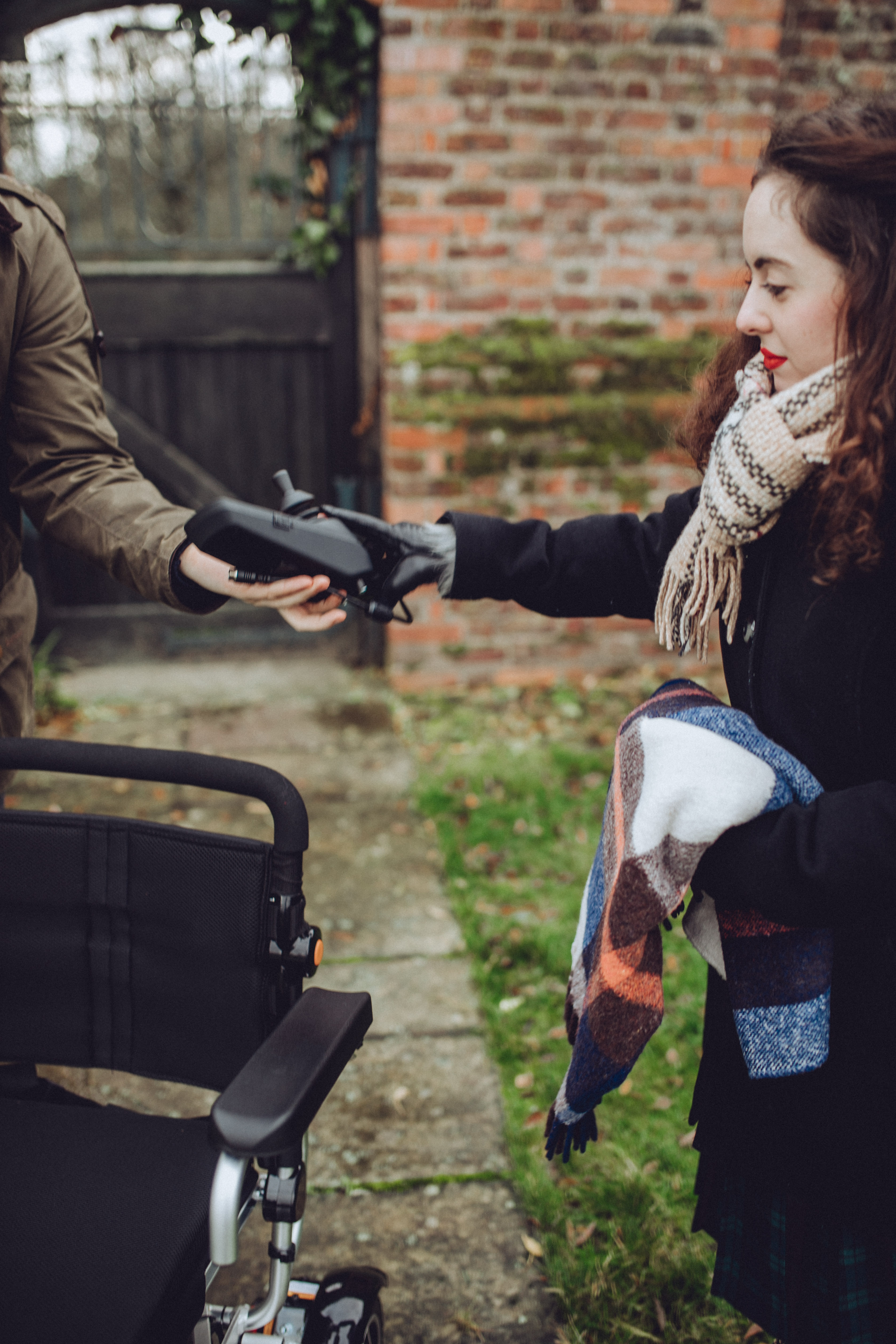
To fold the chair, you:
- Switch it into manual mode and ensure the wheels are facing forward. Remove the console.
- Pull back the arms
- Fold down the top of the seat by pressing the two buttons on either side
- In one sweeping motion you can then fold the chair together by pulling the seat towards the footrest.
The chair has a kickstand, kinda like on a bike, which enables it to stand safely while folded, without the need for someone to hold it. This has come in handy a lot as we’re waiting to load the chair up in certain places, or store it safely in a nice little nook.
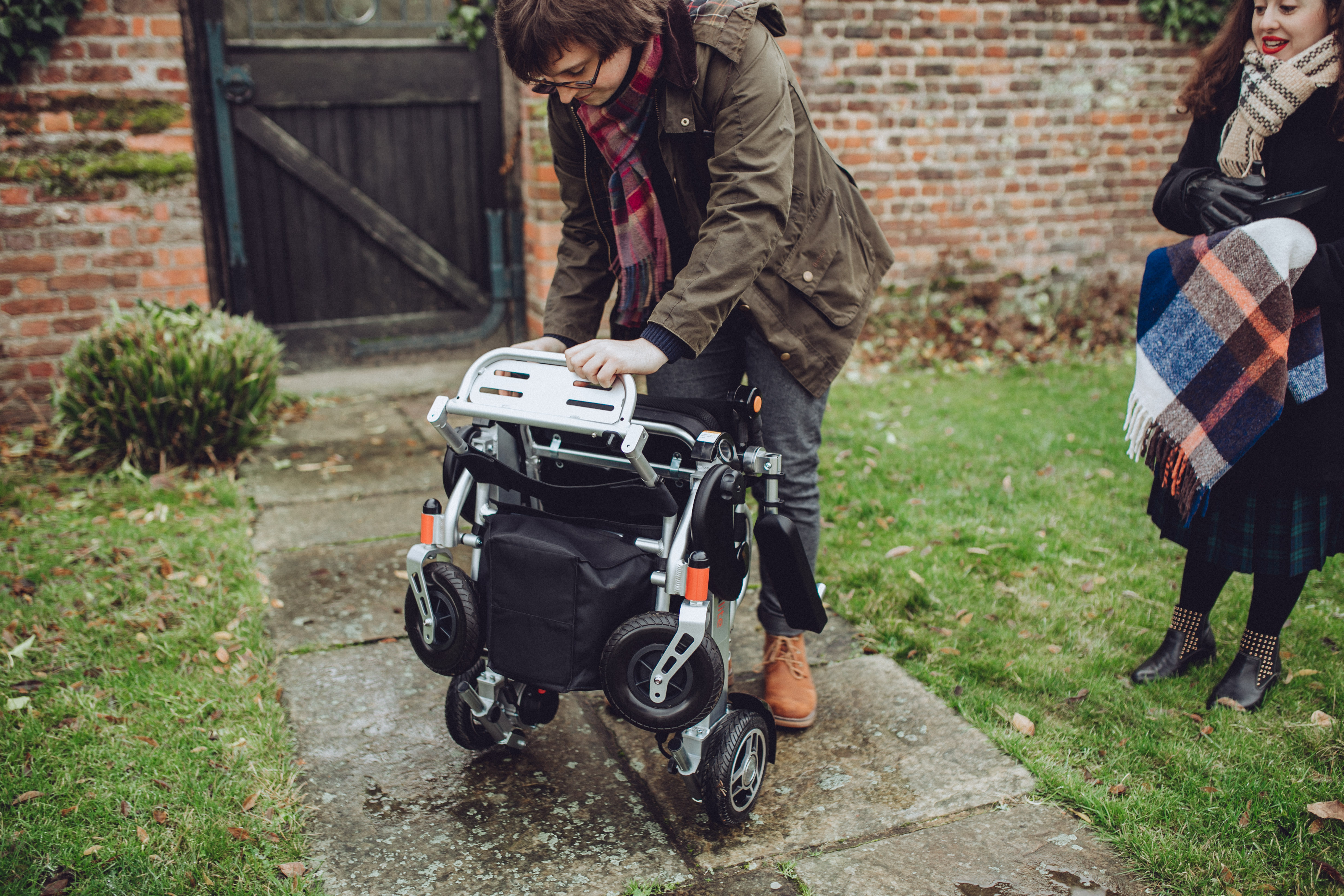
The only annoying bit about the folding process, really, is needing to remove the console every time to ensure it stays safe.
We’ve managed to get this into car boots relatively easily, but if the boot isn’t fully flat and you have to manoeuvre it over the bump thing it can be a tad difficult and takes a little bit of practice. We’ve never not been able to get it into a boot, it just about fits in with the width of all the cars we’ve used.
We travelled to Germany over Christmas and were able to test this out in multiple situations, including trains that have FLIGHTS OF STAIRS TO GET INTO THE ACCESSIBLE CARRIAGE – COLOUR ME THAT, GERMANY.
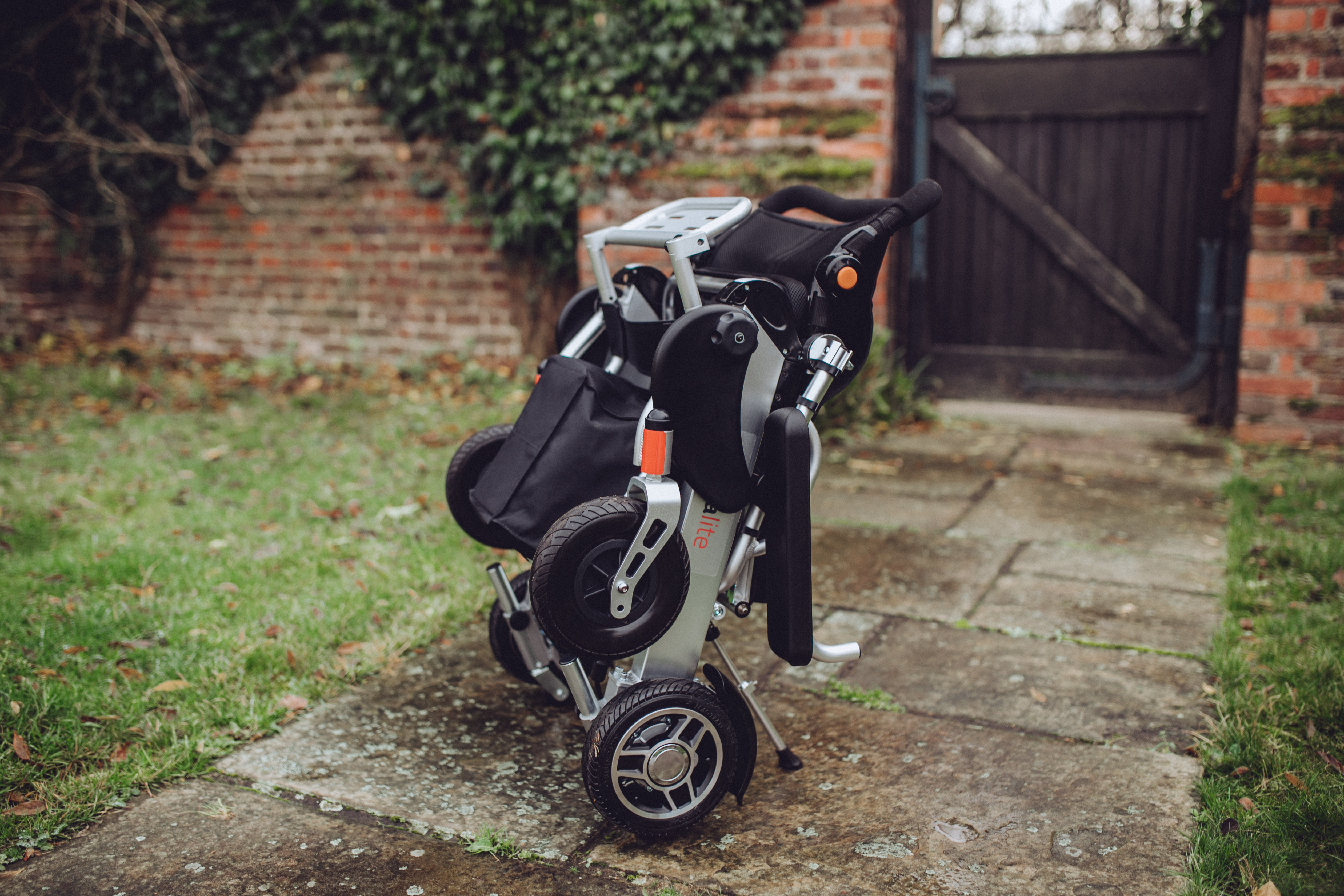
Because I’m able to pop in and out of a chair, this chair has been so much easier to navigate inaccessible transport and roads. It is light enough to be carried, unfolded, (by someone else) without literally requiring 4 men on the tube lifting and carrying me in the chair thanks to a tiny step I couldn’t navigate.
By being strategic with when I jumped out of the chair, I could (as quickly as possible) make my way up the stairs, with Sebastian following carrying the chair without too much trouble. This is something that would have been impossible with my Rascal. I can then either sit in the chair or have it folded in the luggage areas without too much of a problem. It also has bigger wheels than I’m used to, so is able to better navigate small dips that my old chair would simply stop at.
At airports (when they weren’t being shit and traumatising me), we were able to easily take the chair to the door of the plane, take the batteries out, fold it, and then pass to the staff to wheel it into the hold. This has taken a huge amount of pressure off of my airport experiences, and minus the battery side, it pretty much felt like dealing with a buggy in that situation.
The Foldalite also has a manual mode, which means I can be pushed if necessary, which is a nice option to have if there were to be some problem. I spoke to Sebastian about how he finds this experience, and his biggest challenge with it is the lack of traditional handles. He finds that pushing on the bar uses up more energy than if he was having to use handles, and even though he’s sure it wouldn’t break, he’s always worried that it’s not stable enough.
The one thing that we find frustrating with the folding aspect of the chair that we weren’t expecting is that unless you’re on a hyper-smooth surface it doesn’t roll along as easily once it’s folded. This means that at times we’ve driven the chair for very very (very) short distances only to then fold it up outside because we wouldn’t be able to get it from our third floor flat to outside without significant effort. It could just need an oil, but this has been our experience with it!
When it’s cold/raining/snowing, it definitely would have been easier to be able to just roll it outside without having to do that when we were by the car. But on smooth surfaces it works pretty well.
One other thing we thought we would be able to do is tilt the chair with me in it, as that had been shown to us in the demonstration – and it was a big draw. This would mean that if we came across a small drop kerb, I could manually be manoeuvred like in a manual chair, without needing to get out. However, we tested this several times and it only worked when I wasn’t sitting in it. It’s not the biggest problem in the world, but it would have helped me feel a bit safer in public by being able to stay in the chair. But being able to do this in manual mode is incredibly helpful when we come across small issues, and is a big step up to what the Rascal can do in those situations.
COMFORT
I’m so torn about this chair when it comes to comfort. Because in terms of the actual seat itself, I’m disappointed. But in terms of the comfort of not being thrown around all the time, I see a drastic improvement from what I’m used to. Allow me to explain:
As you can see from the image above, my Rascal has a padded seat that feels more like an actual chair than a wheelchair. It’s soft enough while still being supportive and it just feels like my bum is being perfectly cradled by a pair of hold-in tights.
Shut up Natasha.
Aside from aesthetics, I knew immediately when I sat down that it was perfect for me because it was so comfortable and me-sized.
Although there is slight padding on the seat and the ability to adjust the backrest, the Foldalite for me just does not offer that soft but incredibly supportive experience. In fact, when I tested out my Rascal again after using the Foldalite exclusively for a month and a half, I ended up texting my mum about how much more comfortable I found it.
(It’s important to note here that if The Princess and the Pea were a real-life story, I would be that princess. I’m incredibly sensitive).
I find that there’s just a bit too much room in the seat for me and I am a little bit short for it, but that aside, the comfort level just isn’t there in comparison, but you can pretty much tell that by looking at it. That’s not to say that it’s a wildly uncomfortable chair at all, I just find that if I’m out at an event and not transferring to the seat, I do not feel as supported sitting in it for long periods of time.
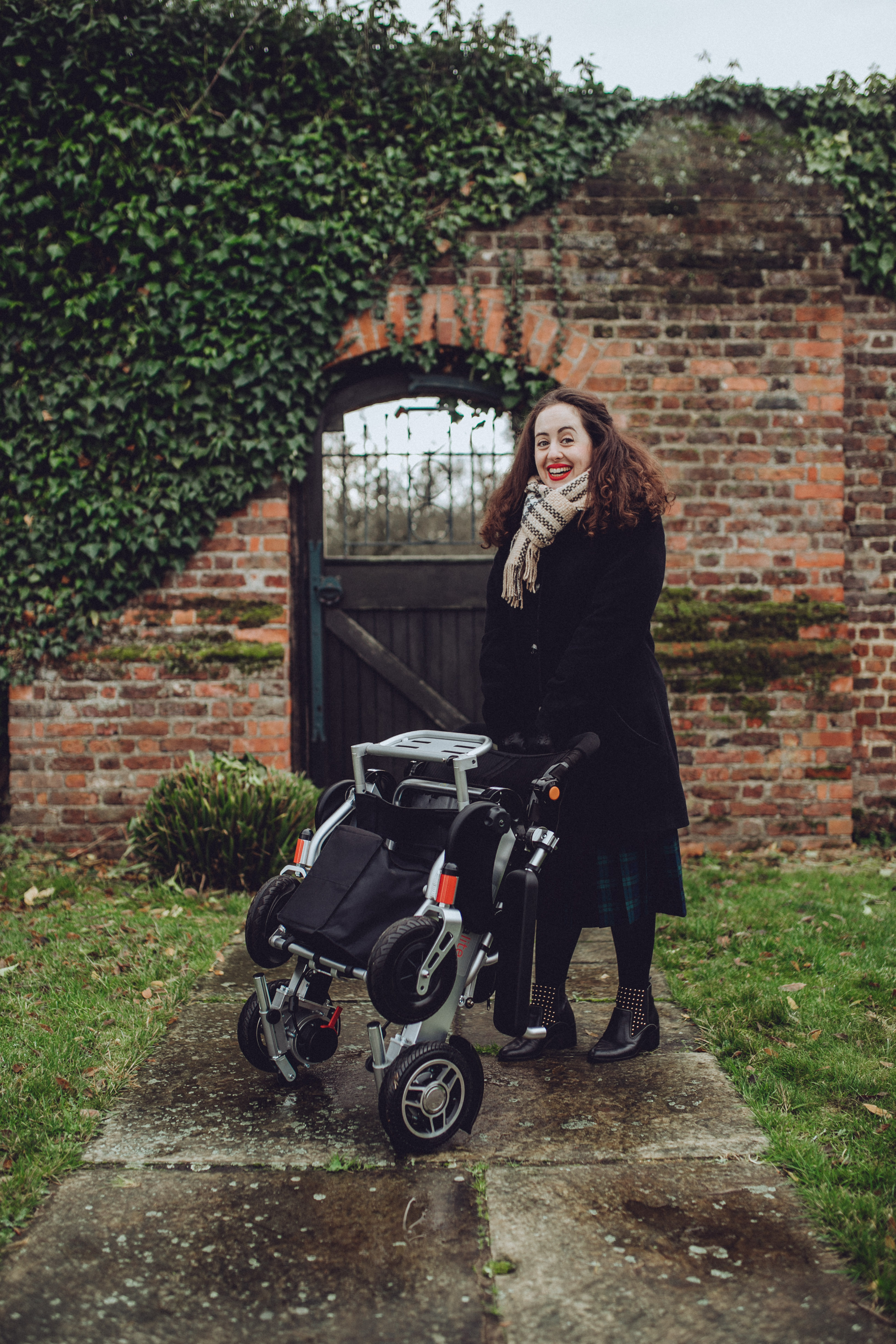
Where I get confused over the comfort thing is the suspension. My Rascal, which although is advertised as a portable chair, is predominantly recommended for indoor use. I became used to being thrown around a lot with the smallest bump in the pavement, and often struggled being out in places that weren’t entirely flat because I ended up in so much pain as a result.
Even some small decorative stuff in the pavement around my building would feel like I was being hit, and getting to the bus stop was always a wildly uncomfortable experience.
The first time I went out in my Foldalite, Sebastian even commented that it LOOKS like I’m having a much smoother experience, as he’s used to seeing me flying around. We took those same decorative pavements and terrible, broken-near-the-bus-stop route, and it just wasn’t happening. There was, of course, some slight shaking, but it was minimal and I don’t have to brace myself in the way that I’m used to.
This is because (and I asked my physicist boyfriend about this and I tried to make it way more simple than explaining the ‘force parallelogram’ that he told me!) the chair is almost like a bike in its design. The frame is angled in a way that redistributes the force from where the wheels are attached, giving it much better shock absorption. This model of the Foldalite isn’t advertised as having notable suspension (compared to it’s Pro model), but next to the Rascal, it’s such a fundamentally better experience thatt while I prefer sitting in the Rascal, I much prefer driving in the Foldalite. So conflicted!
Because of this, I prefer how the Foldalite drives outside, but I was surprised that it took me a while to get used to driving it inside. I can’t physics this, but it almost feels like there’s a bit more drag on the joystick, and that the motor switches on and off much more quickly (which for outside is great) but makes the inside driving experience feel a lot less smooth. Like, it rolls smoothly, it just also…feels different. I don’t even know how to explain it which I know isn’t all that helpful. It drives perfectly fine, but it took me a while to feel like I had full control of the chair when I was using it indoors.
As I mentioned above, I think I’m a tad too small for this chair, which also obviously impacts the comfort level. My Rascal is more short person friendly.For a lot of people the trick of the arms to make the chair wider is probably a great thing, but for me it almost feels too roomy!
I’m going to get a family friend to make a wooden block to attach to the footrest to hopefully make it a bit more comfortable. As you can see in the top image, I keep my feet resting on a different section, but I often do this on my Rascal, too.
Speaking of the footrest, I find that it is quite far away from the chair, and ends up making it difficult for me to gauge my turning circle because it makes the chair way wider/longer(?) at the front than I feel like it is, and still end up driving into things, especially lifts!
The only way to navigate the footrest is to manually, with your hands, detach it from a clip on one side to pull it up. This is something that is too difficult for me to do physically, and I find it frustrating that it does not flip up with a small kick of my foot like my Rascal. I therefore have to go in by lifting the side of the arm up and sliding in.
One thing I’d *love* comfort-wise in the future is the ability to attach a headrest to the back, as I have both chairs because of their size, but being out of bed for very long without my head being supported is always difficult for me.
THE CONSOLE
The Foldalite has a pretty fancy console compared to what I’m used to and it has a fair number of features that could be helpful to some.
On the main screen you can see a circle which lights up depending on how fast you go (I’m often in the red zone because for the first time in my life I can move quickly!) with a battery percentage in the centre. Around the circle on the left and right you can see how much battery power has been used for each of the batteries, which is helpful to know if you just want to charge one.
Personally, I don’t like seeing the exact battery percentage because I find I end up getting a bit too fixated on that in a bit of an obsessive “OH SO THAT JOURNEY USED UP 17%” way (but that’s me!). My first experience with a chair battery was a 5 light countdown, so that is usually enough for me. But maybe I’m not as young and hip and down with the tech as I used to be.

You navigate the console using the joystick, just like on my Rascal. Interestingly, even the first time I tested the Foldalite, the joystick felt different to me. I’m mostly used to it now, but it feels like it has a bit more of a drag, as I mentioned earlier. We think that this has a stronger engine and faster acceleration, which gives this resistance. As I’ve said, my only real experience with a powerchair up until December was with an indoor one, so this could be a perfectly normal thing that I just hadn’t experienced!
You navigate the control using the joystick and buttons underneath the screen. On the left is a button for the menu and on the right is a red SOS which you can press and it starts emitting some relatively loud beeps.
Once you access the menu you have the option to change the language (English and Chinese), set an auto-shutdown of the screen, change the brightness of the screen, turn the sounds on and off for the buttons (I did that because they were too loud for my liking and the first time the chair shut down and it talked to me I nearly jumped out of my skin), and change the settings for how the chair runs.
This is actually something that’s quite cool, because you can have the chair run faster at different settings. I obviously have mine at the highest, but for people who for example struggle with perception and navigation, you can set the chair to run in a way that gives you significantly more control over how it moves.
OTHER FEATURES
There are two features on the chair that are small in the grand scheme of things, but are actually two of my favourites.
Firstly, IT HAS A USB PORT! I AM NOW A PORTABLE CHARGER! AND I LOVE IT.
This not only means I can charge my battery-challenged phone on the go, it means I can plug in a USB heating pad to keep me warm and toasty when I’m out and about. Which is one of my biggest challenges when using a chair in the winter.
The chair also has under seat storage compartment which easily lifts up with velcro and is really handy for storing charging cables, things to keep me dry, or small bits of shopping. When I’m not using that, because the frame of this chair is bigger than my Rascal and the arms come up higher, I’m able to hang a canvas bag from the side to put in some groceries without dragging on the floor, which comes in handy.
The chair also comes with leg guards on each side, which you can fold up or down depending on whether you use them. I was quite excited by this idea, because I could keep people away from my ever-falling-out knees, but I’m too short for them to fall in the right place! But I’m sure it’s a feature that will appeal to many people.
IN CONCLUSION
Overall, I’ve realised that getting a chair ‘off the rack’ seems to be a matter of compromise, unless you’re able to afford the small fortune of getting a chair custom made. It seems that between the Rascal and the Foldalite sits my perfect chair.
As obvious as it sounds, the huge pros to the Foldalite for me lie in the transportability of it. We are able to navigate the Real World with significantly more ease (to the point that my boyfriend now refuses to lift up my Rascal), and it has given me more of the freedom that I had hoped I’d get when I first purchased a powerchair. Of course, I can’t fold it myself, but this isn’t something I ever expected to be able to do because I struggle with day-to-day small tasks. If you’re not able to fold the chair yourself, it will then mean that you’re dependent on someone else to do that for you if that’s what you need.
And although, for me, the chair does not compare in terms of comfort, the improved suspension makes it a more pleasant outdoor driving experience. So, again, it’s a balancing act between the two. What I would definitely say is that for sitting over long periods of time, I would prefer to use my Rascal – but knowing my luck it wouldn’t be accessible to get it where I needed to go without the Foldalite!
With all that in mind, the Foldalite has been what I’ve been reaching for this year, and I have only used the Rascal once for a 10 minute return trip to pick up a package. It’s just so much easier to use for both me and Sebastian, which was one of the things I was really hoping would happen.
For me, the chair is also very expensive (this is all so relative, though, it’s more expensive and way cheaper than many chairs), and it is not something that I’d have been easily able to purchase if it had not been sent to me to review.
However, in the £1000 price difference between this and my Rascal, I am able to use the Foldalite in many more situations, which is something worth thinking about, and it has a lot of small extra features that make it feel new and exciting, including the off-chair charging, the USB charger, and the not-so-modern-but-really-helpful things like the under seat storage.
Overall, I’d highly recommend this chair to someone in a similar situation to me who is looking for an ultra portable chair that doesn’t take up too much space. I’m extremely glad to have been given this opportunity to test it out. Again, I can only speak about my own personal experiences and needs, and yours may be very different to mine! I know that in many ways I am lucky that with my limited mobility, I’m able to pop in and out of the chair if necessary.
With that in mind, I would say to anyone that is looking to purchase a powerchair to go and test it out at your local mobility shop, if this is something you’re able to do. It’s really hard to know until you sit in it and drive it around whether you think it will be the right fit for you.
Thank you so much to CareCo for collaborating with me on this post. You can check out the Foldalite on their website here and the Rascal here.

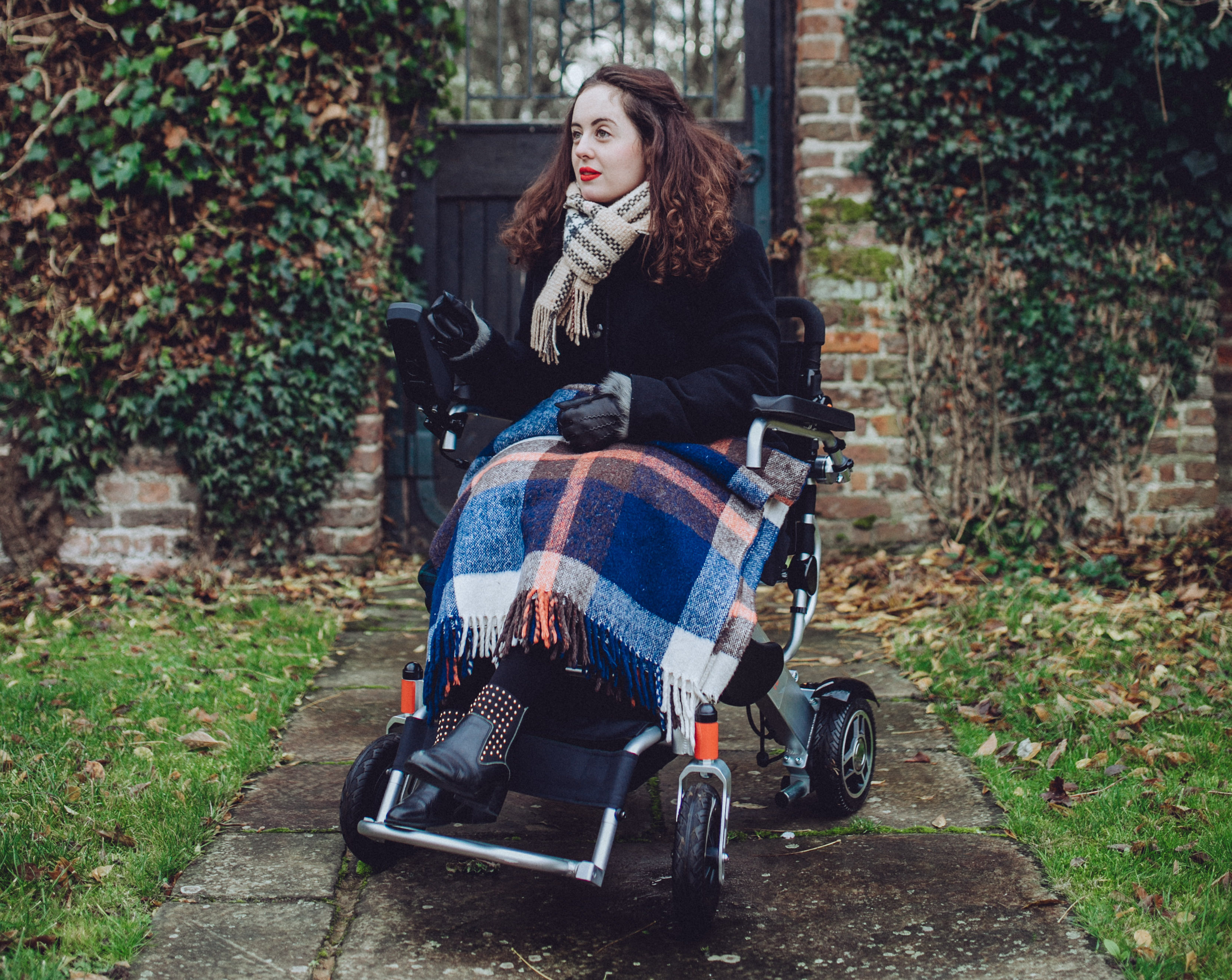
I have one similar to that mines called foldawheelplus my hubby got it for me a couple a years ago
I hope you find it helpful!
Natasha, I am glad that you found a chair which was very comfortable for you and which you can go every where with.
Thank you so much, Silvia!
HI Natasha. Good article. lots of detail. very helpful.
I know about customizing chairs as I have made a few modest changes to the power wheelchair which I use. I would recommend that if you add height to the footrest you have it made with aluminium rather than wood as wood is so heavy.
I have added reflective tape to my power wheelchair and a lot of flashing lights. The best and most inexpensive source for these things is a bike store. The reflective tape is silver and is the most unobtrusive modification. Flashing lights are my thing. We have a lot of traffic and pedestrians on the Inner Harbour in downtown Victoria, British Columbia, where we live. Visibility really works for me. I find that pedestrians and drivers behave differently and better when my lights are on.
Glad you flew with it. I am looking for something similar. My solution so far has been to take my large wheeled rollator (Swedish design) when travelling, but a power chair would be very useful as well.
Great article! Interesting and well written.
Thanks, Allan! I hope you’re able to find a travel powerchair that works for you!
Hi Natasha, I’ve been thinking about getting one of these chairs for a while now, so thank you very much for your post, it’s been very helpful.
Kind Regards.
Shirley
Thank you so much, Shirley! I’m glad it has been helpful for you!
I have a foldalite model which only has one battery but a space for another on the other side ( there is a ‘dummy’ there ). Any thoughts on travelling around with only one battery? I think a spare would cost about £300 and they seem few and far- between…
Hi Brian,
I don’t – sorry. Whether it’s worth it for you is totally dependent on how you use your chair/financial etc so can’t really give any advice on that! I will say it’s absolutely worth making sure to follow battery care best practice as mentioned in your user guide because I was burned on that earlier this year.
I’ve just purchased a foldalite motion pro wheelchair and looking for split charging cable so I can charge off wheelchair at home.
Hello Natasha. Re your review of the foldalite power chair. I found your comments both informative and fun to read…and I read it all!
I have been considering a Foldalite Trekker for a couple of years. My choice of Trekker is because the width of seat suits my ‘frame’ and I very often use off-road paths etc for ‘walks’ with family and friends. My major consideration was the price compared to how I would manage to use it. Whilst Careco allow a test ‘drive’ around the store, this just doesn’t compare in real terrain terms.
If the chair is purchased in-store, and is found to be unsuitable, their return and refund policy is bad. In fact, there is no REFUND policy, just a return-to-store-for-credit policy! I mean, if the chair was returned (for any number of reasons), using a credit of £2000-£3000 is almost impossible to use in-store in my lifetime (I am 72 yrs old). Plus, if I returned it because I was unable to use it, I am unlikely to spend that amount on purchasing another mobility item! If I did the transaction online, I would have to pay CareCo’s costs for the return when, in fact, I could have it returned to my nearest store. Of course, I realise I would have to wait a few days for the refund and this would be acceptable within reason.
Anyway, rant over…
I found your review to be easily understood because you used ‘layman’s talk with no techi-terms. Also you covered one aspect which isn’t usually an issue with most people. I didn’t know the footrest couldn’t be adjusted. I am 4’11” and the short legs/foot rest height is a problem. On uneven terrain, when I find it hard to keep my balance even in a chair! I do not have the ability to grip the armrests to steady myself. Whereas in a manual w/chair, footrest height is adjustable.
OK. That’s all for now. Looking at this small mobile phone screen and using the keyboard has tired out my eyes and hands (dexterity) 🥴 .
Regards and stay safe.
Hi Cal,
Thanks so much for your comment. I’m really glad the review was helpful! I hope you’re able to find the right chair for you!
Hi Natasha,
Hope you are well.
I found your review most helpful prior to purchasing a used Trekker off eBay for my partner who’s paraplegic and can one use her left hand. Careco wouldn’t take it back from the seller who passed away having only used it three times. We only paid £875 used it was a bargain.
I’ve modified ours with some ‘Small Rig’ brackets so I can place the controller on the back of the chair so I can take over if she becomes exhausted.
The rough terrain aspects (including the wide wheelbase) makes it idea for ‘off piste’ grass explorations in parkland etc.
Keep up the good work.
Regards,
David
Hi David,
Thanks so much for sharing, and I’m glad you were able to make the chair work for your partner!